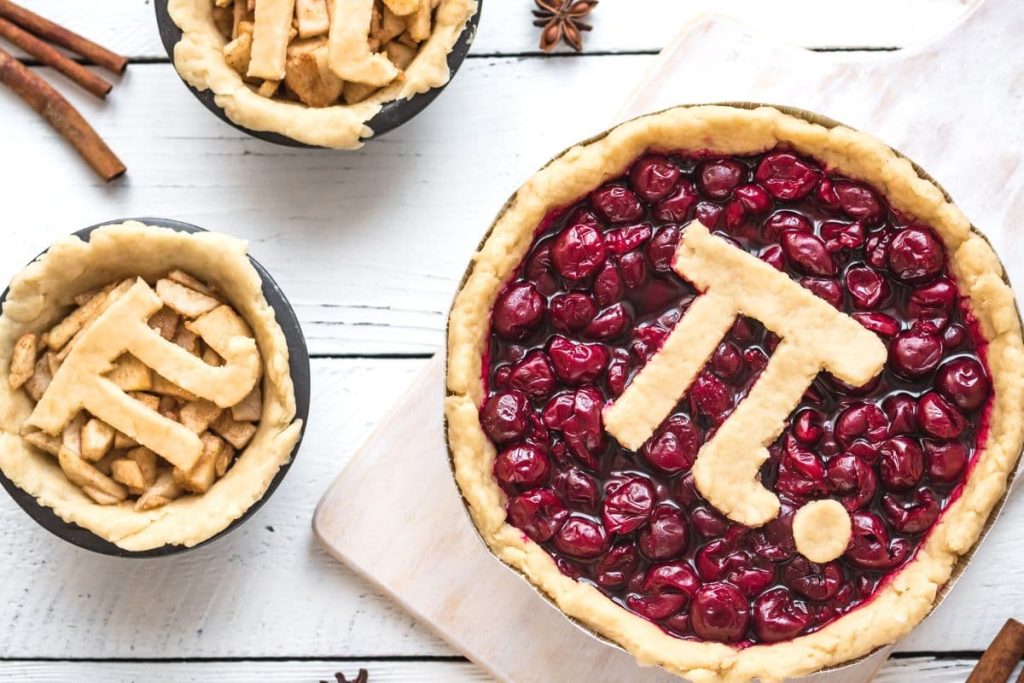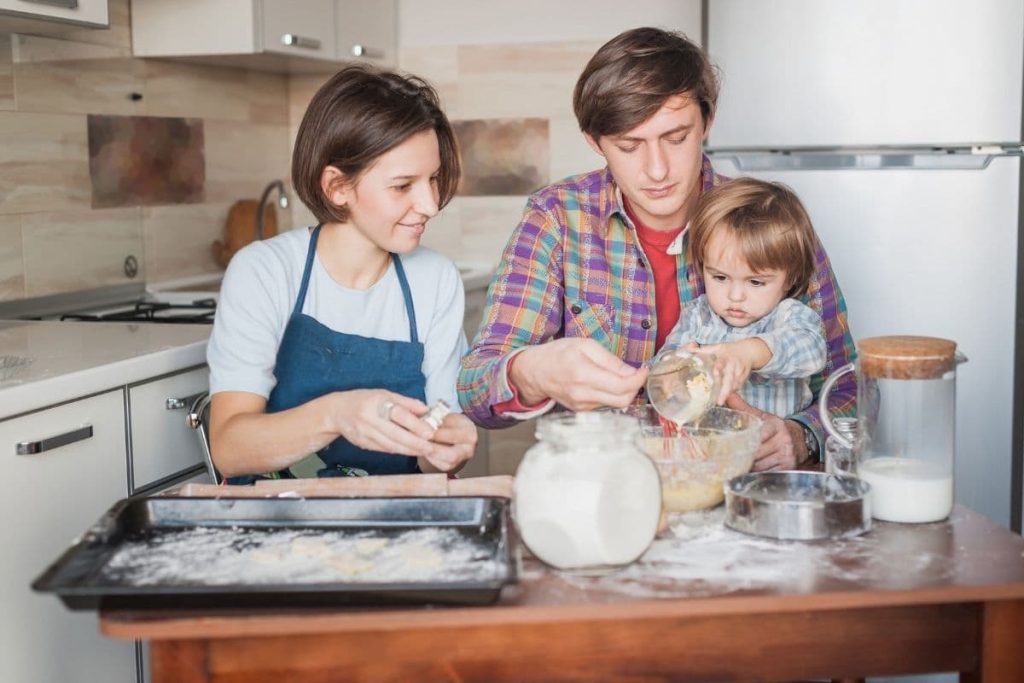Pi Day, celebrated on March 14th, is a delightful opportunity to blend education with fun. This article explores engaging ways to teach your kids about the wonders of mathematics through the art of baking, making Pi Day both educational and enjoyable.
The Significance of Pi Day

Pi Day, observed on March 14th (3/14), is more than just a whimsical holiday; it celebrates one of the most renowned mathematical constants in history: Pi (π). This special day is recognized worldwide by math enthusiasts, educators, and students alike. Pi, approximately equal to 3.14159, is vital in various fields of mathematics and science, particularly in calculations involving circles, spheres, and waves.
The day is marked not only to honor this indispensable number but also to promote a broader appreciation and understanding of mathematics. Pi Day serves as an opportunity for educators to make math more accessible and enjoyable, especially for students who might find the subject challenging or uninteresting.
It’s a day that combines education with fun, often featuring activities like Pi recitation contests, discussions on the history and importance of Pi, and, of course, enjoying pies as a clever nod to the homophone ‘pi.’
Introducing Kids to Pi Day
Introducing children to the concept of Pi Day can be both fun and educational. Begin by explaining Pi in a way that resonates with their level of understanding. For younger kids, you might start by simply saying that Pi is a special number used when we talk about circles. Show them circles in everyday life – like a pizza, a clock, or a wheel – and explain that Pi helps us understand more about these shapes.
For older children, you can go a little deeper. Explain that Pi is an irrational number, which means it goes on forever without repeating, and it’s the ratio of a circle’s circumference (the distance around the circle) to its diameter (the distance across). Highlight the uniqueness of Pi, emphasizing its endless, non-repeating decimal nature and its occurrence in various aspects of science and mathematics.
Mathematical Concepts in Baking
| Mathematical Concept | Baking Activity | Description/How It’s Taught |
|---|---|---|
| Measuring | Measuring ingredients | Teach units of measure (cups, teaspoons) and discuss the precision needed in baking. |
| Fractions | Halving or doubling a recipe | Use recipe adjustments to explain fractions and demonstrate how to combine measurements. |
| Geometry | Baking cakes and pies | Discuss shapes (circles for pies, rectangles for sheet cakes) and introduce concepts like radius. |
| Ratios | Adjusting recipe sizes | Show how ingredient ratios change when altering the size of a recipe, explaining ratio concepts. |
| Estimation | Estimating ingredient amounts | Have children estimate and then measure ingredients, helping them understand estimation. |
| Counting | Counting items (e.g., chocolate chips) | Use counting for ingredient additions, introducing basic arithmetic and number recognition. |
Baking is a fantastic and delicious way to introduce children to practical math concepts. It’s a tangible method for kids to see mathematics in action. When baking, measurements are key – this can be a great way to teach younger children about units of measure like cups, teaspoons, and tablespoons.
Fractions also come naturally into play in baking. Understanding how to half, double, or combine measurements for a recipe introduces children to the concept of fractions in a hands-on manner. For instance, ask your child how many half cups make a whole cup or how to measure ¾ of a cup using a ¼ cup measure.
Moreover, baking can introduce geometric concepts. Discuss shapes and sizes, like the round shape of a cake or pie.
This can lead to a conversation about how circles are related to Pi, tying back to the Pi Day theme. By engaging kids in baking, they not only learn about math but also develop life skills like following instructions, precision, and patience.
These engaging, real-world applications of math can make the subject more appealing and less intimidating for children, showing them that math is not just about numbers and equations but is a part of everyday life.
Simple Pi Day Baking Recipes for Kids

Celebrating Pi Day with your kids can be both educational and delicious, especially when it involves baking. Here are a couple of simple, kid-friendly recipes that not only make for a tasty treat but also offer a fun, hands-on way to learn about Pi.
Pi-Shaped Cookies
Making Pi-shaped cookies is a delightful and straightforward activity. You’ll need your favorite sugar cookie dough, a Pi-shaped cookie cutter (which you can often find online or at specialty baking stores), and some icing for decoration.
Circular Pi Symbol Pie
Baking a circular pie and inscribing the Pi symbol on top is another great way to celebrate Pi Day. You can use any pie recipe that your family enjoys, whether it’s apple, cherry, or even a savory pie like chicken pot pie.
Pi Number Pizza
Pizza is a fun and interactive way to celebrate Pi Day, especially when kids can help in shaping and topping their pizzas.
- Ingredients: Pre-made pizza dough, tomato sauce, cheese, and various toppings of your choice.
- Preparation:
- Preheat your oven as per the pizza dough instructions.
- Roll out the pizza dough into a circular shape.
- Let your kids spread tomato sauce and sprinkle cheese on top.
- Here’s the Pi Day twist: arrange the toppings to form the Pi symbol or the digits of Pi (3.14).
- Bake the pizza as per the dough instructions.
This recipe not only teaches kids about the circle and its relation to Pi but also allows them to experiment with different topping combinations.
Fraction Fruit Tart
A fruit tart is an excellent way to incorporate the concept of fractions, which is a fundamental math skill, and it’s delicious too!
Ingredients: Pre-made tart shells, cream cheese filling, and assorted fruits (like berries, kiwi, and grapes).
Preparation: Fill the pre-made tart shells with cream cheese filling.
Ask your children to place the fruit on the tart in different sections, each representing a fraction of the tart. For example, one half could be blueberries, and the other half strawberries, or divide it into quarters with different fruits.
This activity helps children visualize and understand fractions in a fun and tasty way.
Geometry Jigsaw Puzzle Cookies
These cookies are not only delicious but also a playful way to learn about shapes and how they fit together, much like a jigsaw puzzle.
- Ingredients: Your favorite cookie dough and icing for decoration.
- Preparation:
- Roll out the cookie dough and cut it into various geometric shapes (squares, triangles, rectangles).
- Bake as per your recipe’s instructions.
- Once cooled, challenge your kids to fit the cookies together like a puzzle.
- They can then decorate the cookies with icing, creating designs that match up when the pieces are fit together.
This recipe is an excellent way for kids to learn about different shapes and how they relate to each other, reinforcing basic geometry concepts.
Fun Math Activities While Baking
Baking provides a perfect opportunity to introduce children to practical mathematics in an enjoyable way. Here are some ideas:
- Measuring Ingredients: Use the process of measuring ingredients as a lesson in precision and units of measurement. Ask your kids to measure out flour, sugar, or liquid ingredients, discussing how different measurements (like cups, tablespoons, and liters) are used in baking.
- Calculating Ratios: Teach older kids about ratios by adjusting recipe sizes. For example, if a recipe is for 4 servings and you want to make it for 8, ask them to calculate the new amounts needed for each ingredient.
- Geometry in Action: Use various baking utensils (round pans, square tins, rectangular trays) to discuss shapes and their properties. This can lead to a practical demonstration of how to calculate the area of a circle (πr²) using a round cake or pie.
- Estimating and Counting: Have younger children estimate and then count items like chocolate chips or berries before adding them to a mix. This can be a fun way to practice basic counting and estimation skills.
- Calculating Pi: For a pie, after it’s baked, measure the diameter and circumference of the pie. Then, use the formula circumference = π × diameter to approximate Pi. This hands-on activity makes the abstract concept of Pi more tangible and understandable.
Decorating Baked Goods with Math Themes
Decorating baked goods can be a delightful way to merge creativity with mathematical concepts:
Pi Symbol Decorations: Use icing or fondant to create Pi symbols on cookies, cakes, or pies. This can be a fun way for kids to recognize and remember the symbol for Pi.
Fraction Designs: When decorating something like a cake or a large cookie, divide it into sections and decorate each part differently. This can visually represent fractions and how they make up a whole.
Pattern Creation: Encourage kids to create patterns with their decorations. This can be a simple introduction to sequences and patterns in mathematics.
Number Decorations: Kids can decorate cookies or cupcakes with numbers, creating the digits of Pi in sequence. This can be a sweet way to learn about this infinite number.
Learning and Playing: Making Math Fun
Incorporating educational games and interactive learning into the baking session can transform the way children perceive math:
Math-Based Baking Games: Create a game where children need to solve a math problem to get the next ingredient for the recipe. This can be a playful way to incorporate arithmetic practice.
Shape Sorting: For younger children, use cookie cutters of different shapes and ask them to sort these shapes. Discuss each shape’s properties, like the number of sides and corners.
Time Management Games: Baking also involves timing. Turn this into a game by asking kids to predict how long it will take for something to bake and then check if their prediction was close.
Volume and Capacity Fun: Fill different sized measuring cups with water or another ingredient and ask your child to guess which holds more and why. This can be an introductory lesson on volume and capacity.
Decorating Baked Goods with Math Themes
Decorating baked goods with a math theme can turn a simple baking session into an enjoyable and educational experience. Here are some creative ideas to encourage both artistic expression and mathematical learning:
Number and Symbol Decorations: Use icing, fondant, or edible markers to draw numbers, mathematical symbols, or even simple equations on cookies, cupcakes, or cakes. For Pi Day, decorating with the Pi symbol or the digits of Pi (3.14159…) can be both fun and educational.
Fraction Pies and Cakes: When decorating pies or cakes, you can visually demonstrate fractions. For example, divide a cake into halves, thirds, or quarters using different colors or types of icing. This visual representation can help children better understand the concept of fractions.
Geometric Shape Cookies: Make cookies in different geometric shapes such as circles, squares, triangles, and rectangles. Decorating each shape differently can help children learn to identify and differentiate between these shapes.
Patterned Designs: Create patterned designs on larger cakes or a series of cupcakes. This could be alternating colors, shapes, or sizes in a repeated manner. It’s a great way to introduce children to the concept of patterns and sequences in a playful way.
Measurement Markings: Decorate a rectangular cake to look like a ruler or use a series of cupcakes to represent a measuring tape. This is a novel way to combine baking with learning about measurements.
Learning and Playing: Making Math Fun
Incorporating educational games and interactive learning into the baking process can make math more engaging and less intimidating for children:
Math-Based Scavenger Hunt: Create a scavenger hunt where children need to solve math problems to find the next ingredient or baking tool. For instance, a clue might read, “Find the ingredient that’s the square root of 16,” leading them to pick up 4 eggs.
Measurement Conversion Game: Challenge older children to convert measurements from one unit to another. For example, ask how many tablespoons are in a half cup or convert ounces to grams. This can be a practical lesson in measurement conversions.
Decorating with Shapes and Angles: Encourage kids to use icing or fondant to create different angles or shapes on cakes or cookies. This can be a hands-on way to learn about geometry.
Estimation Jar: Fill a jar with a certain number of small candies or nuts and have the kids estimate how many are inside. This helps with developing estimation skills and understanding quantities.
Baking Time Predictions: Turn the baking time into a game by asking the kids to estimate how long it will take for the cookies or cake to bake fully. Discuss why certain baked goods take longer to bake than others, introducing concepts of heat and chemistry.
Building Memories: The Family Bonding Aspect

Engaging in baking activities with a math theme is not just an educational exercise; it’s a powerful way to strengthen family bonds and create enduring memories.
These activities offer a platform for collaborative learning, where family members work together on everything from measuring ingredients to solving math problems, fostering teamwork and a sense of shared achievement. They also provide an opportunity for parents and older siblings to pass down knowledge and skills, be it in baking or mathematics, enriching the experience for all involved.
Establishing traditions such as celebrating Pi Day annually can create excitement and anticipation, embedding these cherished moments deep within the family’s collective memory.
Baking sessions become a time for storytelling and sharing, allowing parents to connect with their children over tales from their own childhood, thus deepening the emotional connection. In an era where digital distractions are rampant, these activities offer a meaningful and tactile alternative, bringing family members closer in a more genuine and interactive manner.
They also serve as a bridge to one’s cultural and familial heritage, especially when traditional recipes are involved, giving children a sense of belonging and an understanding of their roots. When the baking is complete and the math puzzles solved, the family can collectively revel in their accomplishments, enjoying the delicious outcomes of their teamwork.
This act of celebrating together not only tastes good but also cements emotional bonds.
The warmth of the kitchen, the aromas of baking, and the shared joy of tasting the creations, all contribute to a sense of home and belonging. These moments, rich in learning and affection, are the ones that build the foundation for strong, loving family relationships and become the treasured memories cherished for years to come.
Integrating Other Subjects
Baking, especially when coupled with a theme like Pi Day, presents a unique opportunity to integrate various subjects, making the learning experience rich and multidimensional.
Science in Baking: Baking is essentially a series of chemical reactions, making it a practical and fun way to introduce basic scientific concepts. For instance, you can discuss how yeast makes bread rise by releasing carbon dioxide, or how heat causes ingredients to transform, like batter turning into a cake. This can spark curiosity about chemistry and biology in the kitchen.
Artistic Creativity: Baking also allows for artistic expression. Decorating baked goods can be an art project, where kids use icing, fondant, and other edible decorations to create their designs. This not only cultivates their artistic skills but also encourages them to think creatively and expressively.
Adapting Activities for Different Age Groups
Tailoring baking and math activities to suit different age groups ensures that every child is engaged and learning at an appropriate level.
Activities for Younger Kids: For younger children, focus on simple concepts and basic tasks. This could include counting ingredients, identifying shapes (like circles in cookies or squares in brownies), or simple measuring. The key is to make the activity playful and interactive – think of decorating cookies with bright colors or making simple patterns with fruit toppings on tarts.
Challenges for Older Children: Older kids can handle more complex tasks and concepts. Challenge them with activities like calculating the area of a pie (using Pi), converting measurements (like grams to ounces), or even experimenting with recipe modifications to understand ratios and proportions. You could also engage them in discussions about the scientific aspects of baking, like the Maillard reaction (which causes browning in foods) or how different ingredients interact to create textures and flavors.
Sharing the Fun: Pi Day Celebrations Beyond Home
Pi Day is a joyous occasion that goes beyond home celebrations, enriching both schools and communities with its educational spirit.
Schools contribute significantly by hosting Pi Day events like baking contests and math-themed art exhibitions, fostering student pride and enjoyment in mathematics. In the community, Pi Day events such as bake sales and math fairs, often held at libraries and community centers, encourage public participation.
These include collaborative projects like creating a giant Pi symbol from pies, highlighting teamwork and community engagement.
Children are also encouraged to share their Pi Day experiences, boosting their confidence and helping demystify math for others. Overall, Pi Day’s varied activities make it more than just a celebration, turning it into a meaningful, widespread learning experience that promotes the joy of discovery.
Reflection: What Kids Learn from Pi Day Baking

Pi Day baking is not only enjoyable but also a rich educational experience for kids. It teaches them about the mathematical significance of Pi, including basic concepts like measuring and shape recognition. The activity enhances their problem-solving skills as they follow and adjust recipes, and fosters creativity, especially when they decorate with math themes.
Beyond these cognitive skills, children learn important life lessons like cooking, precision, and the scientific aspects of baking. Baking instills patience and perseverance, as they wait for their creations to cook and cool. Additionally, it encourages teamwork and effective communication when collaborating on baking projects. Overall, Pi Day baking is an enriching activity that combines fun with practical learning, offering children a comprehensive educational experience.
Wrapping Pi Day Up
Pi Day is much more than a mere date on the calendar; it represents a unique convergence of fun, learning, and family bonding. Through the simple yet engaging activity of baking, children are introduced to the fascinating world of mathematics in a way that is both enjoyable and educational. They learn about the significance of Pi, engage in creative problem-solving, and develop important life skills.
Moreover, the celebration of Pi Day extends beyond the home, bringing schools and communities together in a shared spirit of discovery and joy. This widespread celebration not only enhances academic understanding but also fosters a sense of community and teamwork.
Ultimately, Pi Day serves as a delightful reminder of the wonders of mathematics and the joy it can bring into our lives. It’s a day that encourages exploration, creativity, and togetherness, making it a truly enriching experience for everyone involved.






